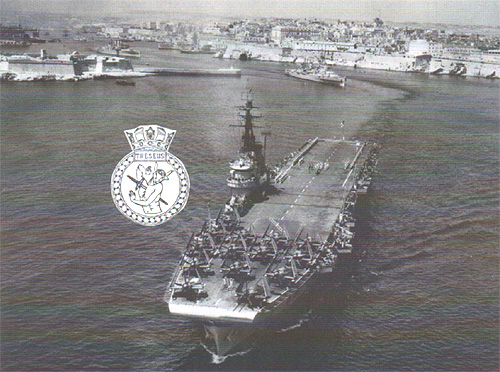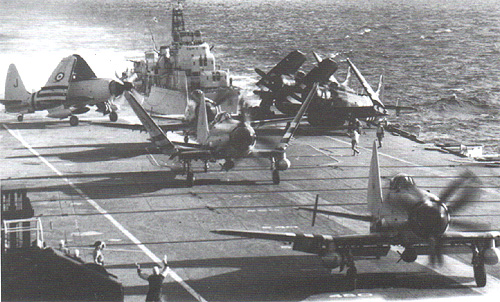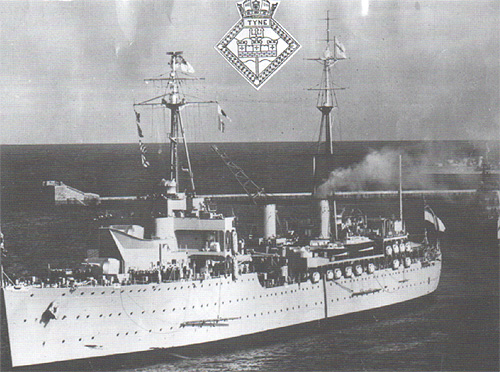|
OPERATIONS
“MUSKETEER” and “TOREADOR”
British Mediterranean
Fleet Aircraft Carriers stream line abreast with The above code-named Operations, the actions carried out to secure the Suez Canal, which had been nationalized by President Gamul Abdul Nasser, took place between 31st October and 6th November 1956. It caused bitter political controversy and the rightness or wrongness of the operations caused fierce debate for a long time. What did stand out afterwards but was swept aside and obliterated in the political wrangling was the effectiveness and complete success of the British Armed Forces and in particular the Royal Navy and the Fleet Air Arm in the various roles they were ordered to carry out. Carrier-borne forces were essential to Musketeer because, as had occurred during the 1939-45 war, from the Norwegian campaign onwards, ground based aircraft on the Mediterranean airfields available were out of range of the combat area for all but heavy bombing raids. The Fleet Air Arm thus provided strikes with the object of destroying the enemy air force on the ground, attacked military installations before troops were landed, covered the landings, and also ferried Commandos ashore by helicopter – the first time such an assault had been carried out, and the success of which led directly to the conversion of carrier into the specialized Commando role. All the tasks were accomplished with great professionalism, vigour and thoroughness. No fewer than five carriers took part: Eagle, Albion, Bulwark providing strike aircraft, while Theseus and Ocean carried out the Marine Commando landings with their helicopters. Lord Halisham, then the First Lord of the Admiralty, describing the specifically naval character of Musketeer said; “The aircraft were largely Naval air-craft, the land forces were largely Marines, and, of course, the carriage was largely by sea”. The immediate task was, neutralization of enemy aircraft on the ground and in the air; Eagle, Bulwark and Albion maintained an independent cycle of operations so that aircraft were over the larger areas throughout each day of the campaign. One pilot reported, “The morale of all squadrons became exceedingly high once the operations started”.
During
the Suez Crisis HMS Theseus, under the command of So the airfields were rendered inoperable, hangars set on fire, control towers destroyed, and aircraft strafed and rocketed on the ground. Dekheila, once an RN Air Station, and well remembered by desert aircrews of disembarked squadrons west of the Canal Zone during the 2nd World War, was so dealt with, as were half a dozen others including Abu Sueir, Fayid, Kabrit, Kasfareet and others. Photographic reconnaissance was flown, and although there were never enough interpreters to extract the full value from the immense amount of film exposed, it was evident that by the end of the second day the enemy air force no longer existed. Taking part in the strikes were seven Sea Hawk squadrons (800, 802, 810, 895, 897 and 899), three Sea Venom squadrons (809, 892 and 893) and one Wyvern squadron (830). At the
same time, anti-submarine patrols were maintained, Skyraiders proved
airborne early warning cover, and carrier airborne patrols were flown.
After the destruction of the enemy air force, the carrier aircraft
turned their attention to military targets. Armoured cars, tanks and
all kinds of army transport were rocketed, strafed
Bulwark’s aircraft claimed 102 enemy bombers and fighters destroyed or damaged; 18 medium and heavy tanks; and two E-boats sunk. Eagle, Albion and Bulwark, between them, flew nearly 1,300 offensive sorties on these first five days, with pilots carrying out up to four strikes a day. The airborne landings began on the 5th November. French and British parachute troops being dropped, while the carriers provided standing patrols in support. The outskirts of Port Said and Port Fuad were captured by that evening, while naval helicopters supplied the forces with ammunition and food. The following morning at dawn, beach defences were attacked and the first Commandos went ashore just before 0500.
Theseus and Ocean then began, with the helicopters of 845 Naval Air Squadron and the Joint Experimental Helicopter Unit to transport 45 Royal Marine Commando into the battle zone with their equipment and ammunition. Five hundred men were ferried ashore, and casualties evacuated, while, once again, strike aircraft provided cover. By the evening, Port Said had been captured and the Anglo-French troops were advancing along the Suez Canal.
But, at midnight on the 6th November, in the face of political pressures, there was a cease fire. Operation Musketeer was over. The Fleet Air Arm, for its part, had carried out the tasks for which it was trained, and carried them out exceedingly well.
|





